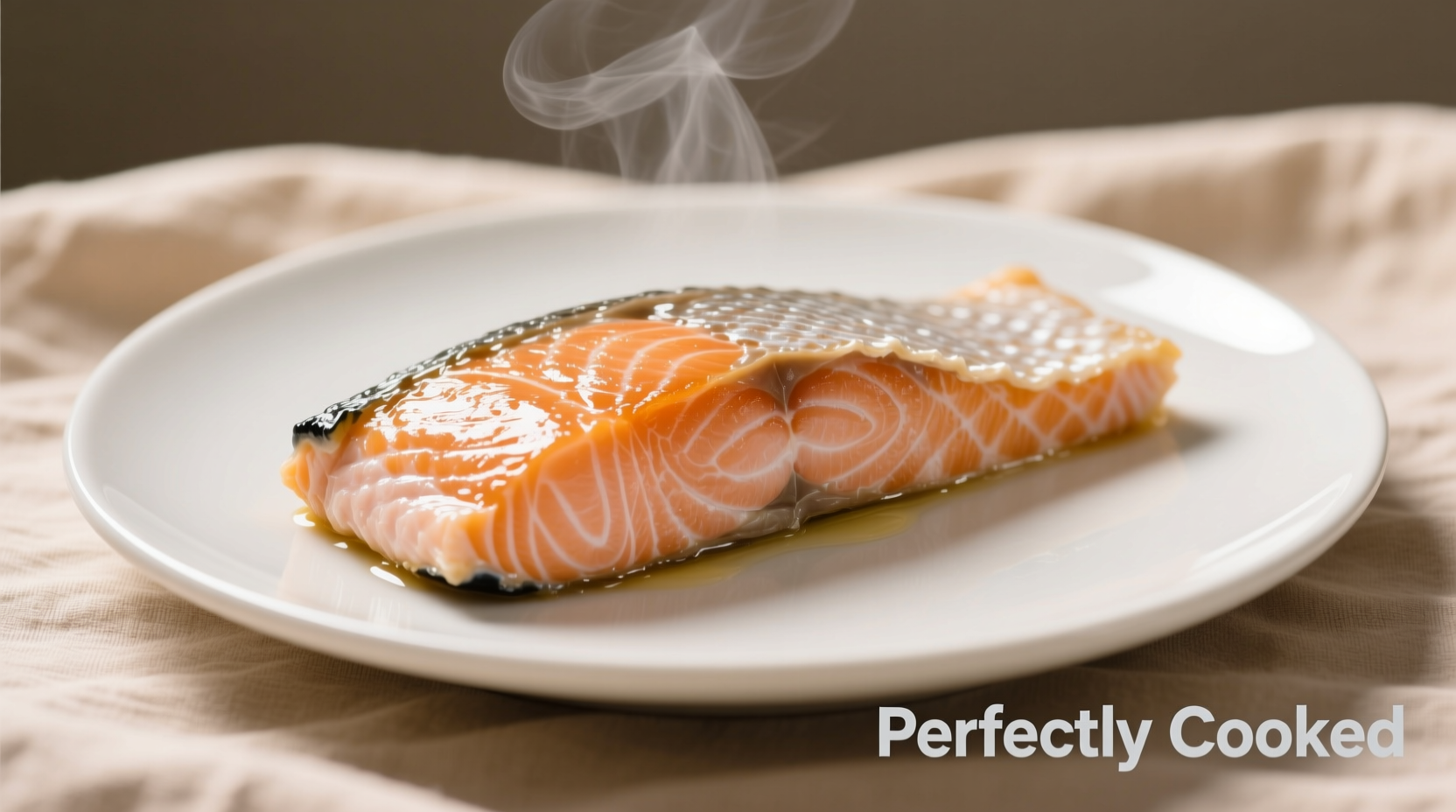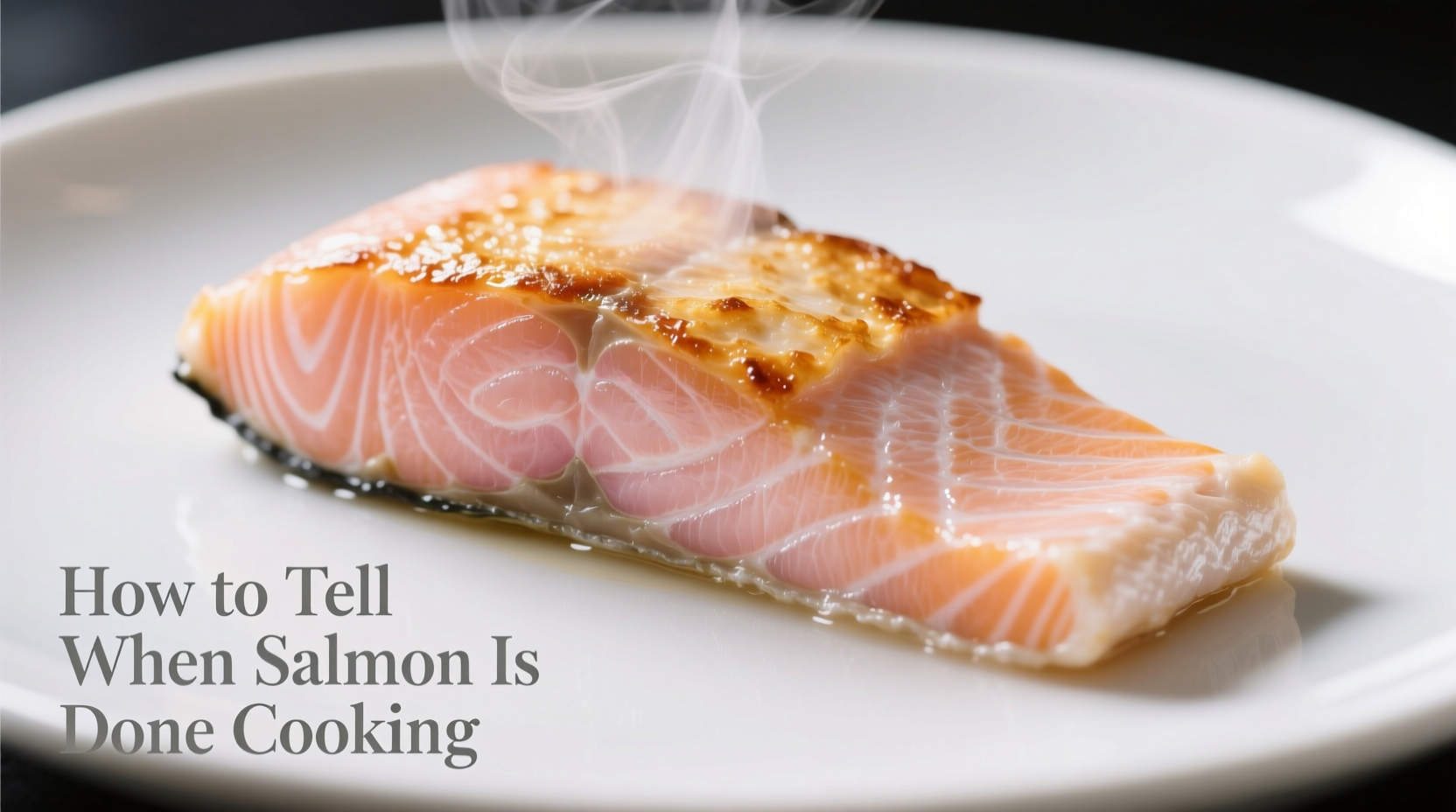The Science Behind Perfectly Cooked Salmon
Knowing exactly when salmon is done cooking prevents both food safety risks from undercooking and the disappointment of dry, overcooked fish. Unlike meat with higher fat content, salmon has delicate proteins that quickly become tough when exposed to heat beyond the ideal temperature range.
Three Reliable Methods to Check Salmon Doneness
1. The Thermometer Method (Most Accurate)
According to the USDA Food Safety and Inspection Service, fish should reach a minimum internal temperature of 145°F (63°C) measured with a food thermometer. However, many chefs prefer these temperature ranges for optimal texture:
| Doneness Level | Internal Temperature | Texture Characteristics |
|---|---|---|
| Medium-Rare | 120-125°F (49-52°C) | Slightly translucent center, very moist |
| Medium | 130-135°F (54-57°C) | Mostly opaque with slight translucency in center |
| Fully Cooked | 140-145°F (60-63°C) | Completely opaque, flakes easily |
Insert your thermometer into the thickest part of the fillet, avoiding the bone if present. Remember that salmon continues cooking for 3-5 minutes after removal from heat due to carryover cooking.
2. The Visual Inspection Technique
When you don't have a thermometer available, these visual cues reliably indicate doneness:
- Color transformation: Raw salmon appears deep orange-red and translucent. As it cooks, it becomes opaque pink, progressing from the bottom up
- Flaking test: Gently press the top of the fillet with a fork. Properly cooked salmon will flake along natural lines but still hold together
- Translucency check: When about 75% of the salmon has turned opaque, it's nearly done. Remove it from heat as it will continue cooking

3. The Touch Test for Experienced Cooks
Professional chefs often use the touch method to gauge doneness:
- Press the top of your salmon fillet gently with your finger
- Compare the resistance to the fleshy part of your palm below your thumb
- Raw salmon feels like the soft area when your hand is completely relaxed
- Perfectly cooked salmon has the firmness of your palm when you touch your thumb and index finger together
Cooking Method Variations and Timing Guidelines
The time it takes for salmon to cook depends significantly on your cooking method. These guidelines apply to standard 1-inch thick fillets:
Pan-Seared Salmon
Cook skin-side down for 6-8 minutes until the edges turn opaque, then flip and cook 2-3 minutes more. The skin should release easily from the pan when properly seared.
Baked or Roasted Salmon
At 400°F (204°C), bake for 10-12 minutes. For slow-roasting at 275°F (135°C), allow 20-25 minutes. The lower temperature method produces more evenly cooked results with less risk of overcooking.
Grilled Salmon
Place skin-side down on medium-high heat for 6-8 minutes until the fish releases naturally from the grates, then flip and cook 2-4 minutes more. Direct heat requires careful monitoring to prevent burning.
Avoiding Common Salmon Cooking Mistakes
Even experienced cooks make these errors when preparing salmon:
Mistake: Overcooking for "safety"
While the USDA recommends 145°F for food safety, high-quality fresh or previously frozen salmon can be safely enjoyed at 125°F. The FDA states that freezing kills parasites that may be present in raw fish, making medium-rare preparation safe with properly handled fish.
Mistake: Moving salmon too soon
When pan-searing, resist the urge to move the salmon during the first 3-4 minutes. Proper searing requires the fish to release naturally from the pan when ready to flip.
Mistake: Skipping the resting period
Always let salmon rest for 3-5 minutes after cooking. This allows the proteins to relax and redistribute moisture throughout the fillet, preventing dryness.
Special Considerations for Different Salmon Types
Not all salmon behaves the same when cooking. Wild-caught salmon typically has less fat than farmed varieties, meaning it:
- Cooks slightly faster
- Requires more careful temperature monitoring
- Benefits from lower cooking temperatures
- Is best served at medium-rare (125°F) for optimal moisture retention
Farmed Atlantic salmon's higher fat content provides more margin for error but can become unpleasantly oily if overcooked.
What to Do If You've Overcooked or Undercooked Salmon
Salmon is Undercooked
If your salmon is still translucent after the expected cooking time:
- Return to heat for 1-2 minute intervals, checking frequently
- For pan cooking, reduce heat to prevent exterior burning
- Consider finishing in a 350°F (177°C) oven for more even cooking
Salmon is Overcooked
Rescue dry salmon by:
- Serving with a flavorful sauce like lemon-dill yogurt or herb butter
- Flaking and mixing with mayonnaise for salmon salad
- Chopping and incorporating into fish cakes with additional moisture
Pro Tips for Perfect Salmon Every Time
- Dry the surface: Pat salmon thoroughly with paper towels before cooking for better searing
- Room temperature start: Let refrigerated salmon sit at room temperature for 15-20 minutes before cooking
- Skin-on advantage: Cooking with skin on provides a protective layer and makes handling easier
- Oil selection: Use high smoke-point oils like avocado or grapeseed for searing
Frequently Asked Questions
How can you tell if salmon is done without a thermometer?
Watch for the color to change from translucent to opaque pink, check that it flakes easily with a fork but still holds together, and note when the white albumin (protein) begins to appear on the surface. When about 75% of the salmon has turned opaque, it's nearly done.
Is it safe to eat salmon that's still slightly translucent in the center?
Yes, if the salmon has been properly handled and previously frozen. The FDA states that freezing kills parasites that may be present in raw fish. High-quality salmon cooked to 125°F is safe to eat and preferred by many chefs for optimal texture and moisture.
Why does my salmon stick to the pan when I try to flip it?
Salmon sticks when it hasn't developed a proper sear. Ensure your pan is properly preheated, the salmon surface is dry, and give it 3-4 minutes without moving it. Properly seared salmon will release naturally from the pan when ready to flip.
How long should salmon rest after cooking?
Rest salmon for 3-5 minutes after cooking. This allows the proteins to relax and redistribute moisture throughout the fillet. Larger cuts may need up to 10 minutes of resting time. Always tent with foil to retain heat during resting.











 浙公网安备
33010002000092号
浙公网安备
33010002000092号 浙B2-20120091-4
浙B2-20120091-4